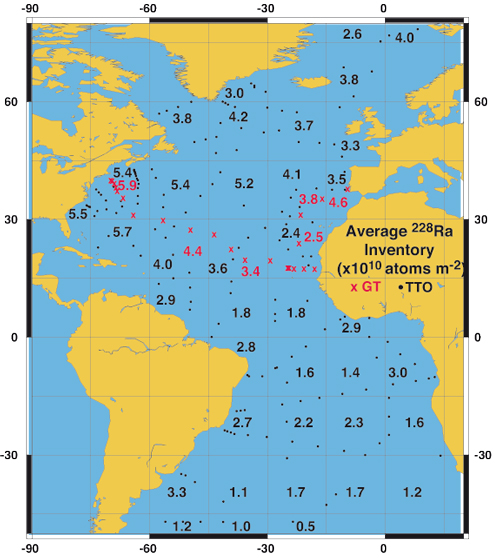Radium quartet reveals no less than four main processes along the GEOTRACES North Atlantic Ocean section (30°N)
The four radium (Ra) isotopes (224Ra, 223Ra, 228Ra, 226Ra, “radium quartet”) are produced in situ via decay of their insoluble thorium isotope parents in sediments from the continental margins and deep-sea and then released to the ocean. In the ocean, their distributions are controlled by particle removal (226Ra) and radioactive decay with four different half-lives. These properties make the “quartet” an invaluable tracer of coast-to-ocean processes and a water mass spreading chronometer.
Thanks to a dense and beautiful data set documenting the radium quartet along the 30°N GEOTRACES US section (GA03), Charette and co-authors (2015, see reference below) were able to identify:
- a Mediterranean outflow spreading rate of 0.52-0.60 cm/s derived from 228Ra,
- evidence of substantial sediment/water interaction in the benthic boundary layer along the oxygen minimum zones
- decoupling between 223Ra and the other Ra isotope sources over the mid-Atlantic Ridge, and
- significant continental inputs (e.g. submarine groundwater discharge) in the western Atlantic.
Last but not least, they conclude that the 228Ra inventories in the upper water column have remained constant over the past 40 years, which suggests that submarine groundwater discharge (the primary 228Ra source) is steady-state for the North Atlantic on decadal time scales.

Figure. Box average 0-1000 m inventories (15° x 15°) of 228Ra (x 1010 atoms m-2) for samples collected on the GEOTRACES Atlantic section (GT) (2010-2011) and the Transient Tracers in the Ocean cruises (TTO) (1981-1986). Each solid black dot is a TTO station, each red x is a GT station. Click here to view the figure larger.
Reference:
Charette, M. A., Morris, P. J., Henderson, P. B., & Moore, W. S. (2015). Radium isotope distributions during the US GEOTRACES North Atlantic cruises. Marine Chemistry, In Press doi:10.1016/j.marchem.2015.01.001 Click here to access the paper.
